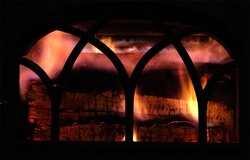So I've been monitoring my temps on the center of the little faux griddle on the top of the 500 with a standard Rutland stove therm. I know it's not the best thermometer but I figure it's within 100 degrees or so and I can "feel" the fire well enough to avoid smoke/overfiring...or so I thought.
Well, I looked at the manual and noticed that I'm supposed to put it "...directly on the corner of the stove's top plate." Well, noticing there are 4 corners to a rectangle, I arbitrarily chose the back rear corner. But I noticed the temp is about 200 degrees lower than the center of the "griddle."
Tonight, I put a load of wood in on good coals, charred it for about 2 minutes, then backed the primary down to 50% thinking it would be fine while I walked next door for 10 minutes (literally). When I came back my wife told me the room smelled like curing paint (just as it did when we broke it in) and she backed it down to 25%. But when I came in a few seconds later I could see the fire was boiling inside, the logs were all glowing red and the upper baffle was just beginning to glow on the edge closest to the flame (front of the firebox). Thermometer reading was 500 degrees. Right now, 15 minutes later, the temp is still at 500 but the upper is no longer glowing.
Honestly, I figured I might have an excessive draft problem given that my chimney sucks air hard when it's cold, let alone when there's a fire. But now that I've transitioned from a smoke dragon to a modern stove I'm just not sure what excessive draft and burn tubes look like. My secondaries light off fine but they look like blow torches, no lazy flames here and they're blue, barely any yellow at all. My old VC Resolute would routinely glow on windy nights with the damper closed :bug: until I figured how to choke everything down tight enough (even had to close the secondary intake).
So here's my questions:
1. Am I really putting the thermometer in the right place? How can it be 500 degrees and the upper baffle start to glow? and
2. How do I know if I have excessive draft?
Well, I looked at the manual and noticed that I'm supposed to put it "...directly on the corner of the stove's top plate." Well, noticing there are 4 corners to a rectangle, I arbitrarily chose the back rear corner. But I noticed the temp is about 200 degrees lower than the center of the "griddle."
Tonight, I put a load of wood in on good coals, charred it for about 2 minutes, then backed the primary down to 50% thinking it would be fine while I walked next door for 10 minutes (literally). When I came back my wife told me the room smelled like curing paint (just as it did when we broke it in) and she backed it down to 25%. But when I came in a few seconds later I could see the fire was boiling inside, the logs were all glowing red and the upper baffle was just beginning to glow on the edge closest to the flame (front of the firebox). Thermometer reading was 500 degrees. Right now, 15 minutes later, the temp is still at 500 but the upper is no longer glowing.
Honestly, I figured I might have an excessive draft problem given that my chimney sucks air hard when it's cold, let alone when there's a fire. But now that I've transitioned from a smoke dragon to a modern stove I'm just not sure what excessive draft and burn tubes look like. My secondaries light off fine but they look like blow torches, no lazy flames here and they're blue, barely any yellow at all. My old VC Resolute would routinely glow on windy nights with the damper closed :bug: until I figured how to choke everything down tight enough (even had to close the secondary intake).
So here's my questions:
1. Am I really putting the thermometer in the right place? How can it be 500 degrees and the upper baffle start to glow? and
2. How do I know if I have excessive draft?



